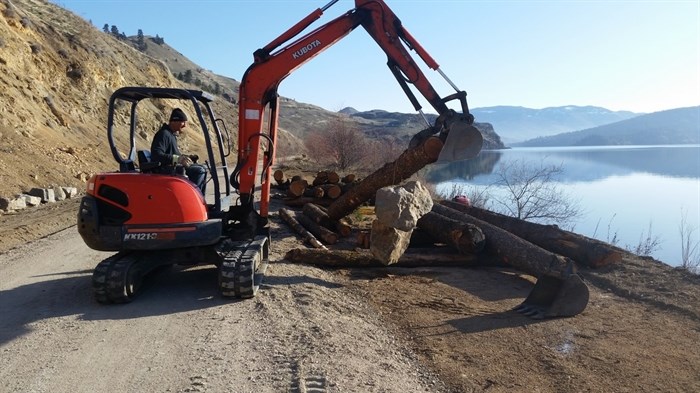
Work proceeds on the Okanagan Rail Trail, spring 2018.
Image Credit: SUBMITTED
May 08, 2018 - 5:22 PM
From missing fences to actual legal titles, the Okanagan Rail Trail from Kelowna to Vernon still has some significant gaps that have left it looking more like a dotted line than a trail from point A to B.
The already popular 49-kilometre Okanagan Rail Trail — they're having trouble keeping people off it — has been billed as a linear path but the gaps, some which have no confirmed completion date, leaves the opening of the full trail up in the air.
Okanagan Rail Trail Initiative spokesman Brad Clements said the unexpected challenges means the interjurisdictional development team has had to change its thinking even though the $7.8 million needed to construct the basic trail is almost all in place.
“When we started campaigning, we decided that none of the trail was going to open until all of the money was raised,” he said. “As we began construction and these gaps came up we changed our attitude."
The most significant gap, and the one with the least certain closing date, is a seven-kilometre section from just north of UBC Okanagan into Lake Country.
Part of that section runs across Okanagan Indian Band’s IR#7 near Duck Lake. The band is in the midst of a two-part process that involves the transfer of the CN Rail right-of-way, first to the federal government then to the band, project leader Andrew Gibbs said.
While the band is a partner in the rail trail, the federal land transfer must be completed first before band members vote on whether to give over the land to the rail trail. No date has been set for this process to be completed but it’s expected to be at least a year.
The rail trail development team is also still negotiating with CN for purchase of “Mile 88” the last piece of the trail at the Vernon end, according to Mike Fox, general manager of community services for the North Okanagan Regional District.
“It wasn’t included in the original sale. Past mile 88, the rail line was still active and they weren’t sure if they were going to use it,” Fox said. “Now they have determined it is not going to be in use.”
Meanwhile, Clements said the B.C. Agricultural Land Commission has proven to be an unexpected source of delay as it rules on several applications by individual jurisdictions to change the use of the land from a railway track to a linear trail.
As part of that, the land commission is requiring fencing along portions of the rail trail that parallel agricultural land along with warning signs notifying rail trail users that agriculture is in progress, with all its attendant dangers.
The land commission did not respond to requests for an interview.
While not an immediate threat to its opening, the 2017 flood lead to erosion of the trail bed along Kalamalka Lake and to a lesser extent Wood Lake, Clements said. The sections total approximately four kilometres and required about $1 million in repairs even as construction of the trail continued.
Clements said lower initial construction costs allowed them to complete the repairs from donated funds but the flooding has revealed a vulnerability that may require future remediation.
The bill could have been as high as $4 million had the development team opted to place rip-rap rock along the eroded sections, however consultants came up with a cheaper option using rocks, logs and natural vegetation, Clements added.
To contact a reporter for this story, email John McDonald or call 250-808-0143 or email the editor. You can also submit photos, videos or news tips to the newsroom and be entered to win a monthly prize draw.
News from © iNFOnews, 2018